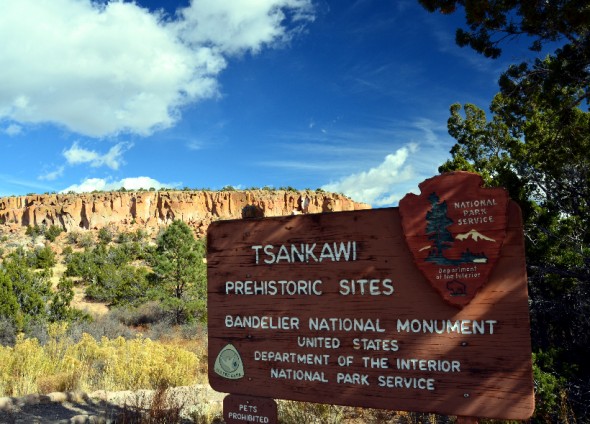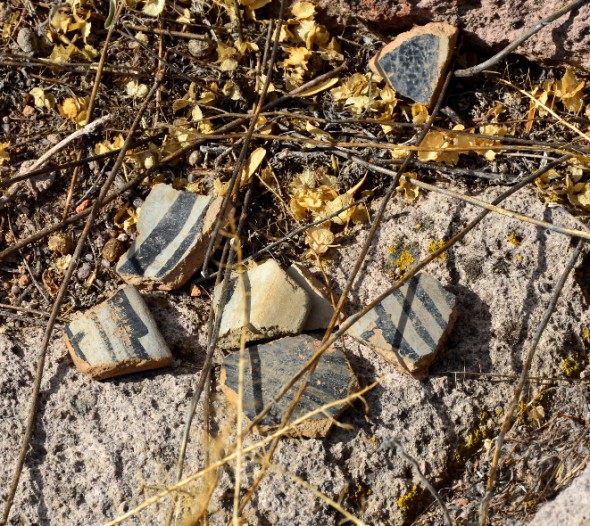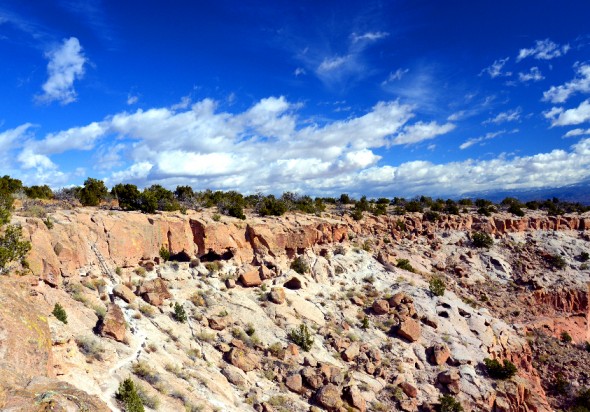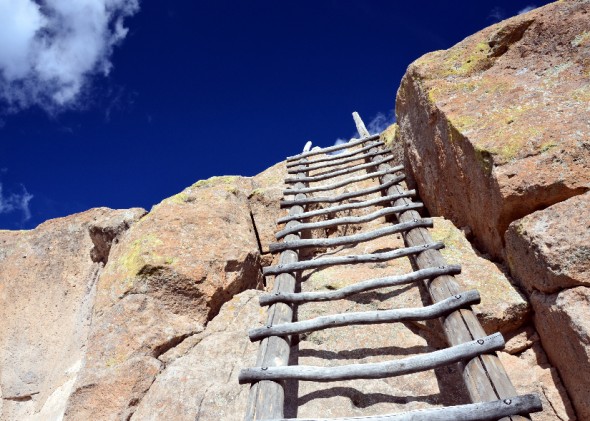
Tsankawi Indian ruins near White Rock New Mexico make for great winter hikes due to its greater exposure to sunshine and the spectacular views.
Sitting upon the edge of a cliff at Tsankawi, legs dangling in space, basking in the midwinter sun, one can look out over the snow dusted valley below and perhaps understand why the ancient Indians choose to live here hundreds of years ago.
Today it offers visitors spectacular views, a great winter hike and a quiet, contemplative place in which to consider what life must have been like for the native people over 400 years ago.

Views of the Rio Grande Valley and opposing Sangre de Cristo mountains are incredible from Tsankawi.
High atop this mesa, ancestors of San Ildefonso Pueblo built a village and on the south facing cliff face, they carved out shallow caves in the soft volcanic rock where they cooked, slept and hid from the elements.

Caves carved out of the soft volcanic rock provided living quarters for the native Indians that inhabited Tsankawi.
Their comings and goings cut deep trails into the soft rock crisscrossing the site and following them leads one into a glimpse of what their world must have been like then.

Well worn trails in the soft volcanic rock mark where those who lived here once traversed the mesa.
In the valley floor below they grew dry land crops such as corn, beans and squash, gathered wood and water and hunted game.

It’s easy to see why Tsankawi was an ideal location for native people to live at the time.
High atop the mesa visitors will find the ruins of what was once an extensive housing project of over 275 rooms built from local rocks.

The ruins of a great village built of stone sit atop the mesa at Tsankawi.
Stepping carefully amid the rocky ruins of the mesa top village a sharp eye may see that someone has placed a couple of pottery shards atop a flat rock. They should be left them alone because this is an outdoor museum and removing them is a federal law offense.

Pottery shards abound at amid the ruins of the Tsankawi.
And on the trail below, if one stops often enough to look up at the rock walls above, a visitor may see one of the many messages that the Indians left behind, like a large spiral carved in the rock or a depiction of an animal.

Petroglyphs adorn many of the flat rock surfaces found at Tsankawi.
On the far end of the loop trail visitors will find a ladder leading down a set of caves carved into the hillside which provide good southern facing exposure to the warming rays of the sun.

South facing caves at Tsankawi would have provided native residents a warmer place to shelter during colder winter months.
The rock here was formed by residue from the volcanic eruption of the nearby Jemez Mountains which also formed the massive, grassy meadows of the nearby Valles Caldera National Preserve. The soft rock that makes up the colorful mesas, buttes and canyons in the surrounding area is easily eroded by water and also easy to excavate.

Visitors to Tsankawi will find an easy one and half mile hike along trails carved out of the soft volcanic tuff.
Tsankawi is an intriguing 1.5 mile hike involving a climb up and down three sets of ladders fashioned from lodge poles, incredible scenic views and a great deal of Native American history as spelled out in a guided, numerical tour pamphlet available at the park entrance.

Ladders provide a quick fun way up to onto the mesa top but those who wish to avoid them can easily find another way.
Tsankawi is a remote section of Bandelier National Monument which is located about 15 miles farther south on State Rd. 4 after passing through the town of White Rock. A $12 entrance fee per vehicle is required and is good for entrance to all of Bandelier for 7 days.

The author points to one of the bigger murals carved into the soft rock depicting what looks like a family portrait.
It is believed that those who lived at Tsankawi are the ancestors of the Indian’s of San Ildefonso Pueblo who left their mesa top village sometime during the 1500s to relocate in the valley below along the banks of the Rio Grande.













